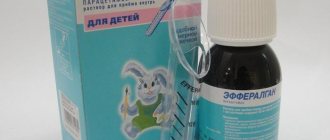An allergy is a pathological response of the immune system, which is expressed in a hypersensitive reaction of the body to substances from the environment. Allergens include dust, insect bites, pollen, food, and medications. Reactions can be benign (runny nose, itching, urticaria) and life-threatening (anaphylactic shock, Quincke's edema).
Many special drugs have already been created to suppress allergy symptoms. One of them is Suprastin. Is it possible to give Suprastin to children? How to take the medicine - before or after meals? Let's answer these and other questions.
Composition, description and effect of the drug
Suprastin is a first generation antihistamine drug. It has an antiallergic effect. When an allergen enters the body, the immune system releases histamine, which, when interacting with substances produced by other receptors, causes reactions in the form of itching, rashes, and swelling. Suprastin contains chloropyramine, an H1-histamine receptor blocker that suppresses the formation of histamine.
The drug has an m-anticholinergic effect (decreasing the tone of the gastrointestinal tract, gall bladder and biliary tract). In addition, it prevents vomiting and eliminates spasms of bronchial smooth muscles.
Absorption occurs through the gastrointestinal tract. The therapeutic effect begins 20-30 minutes after administration and reaches its maximum value after 60 minutes. The drug acts for at least 6 hours and is excreted through the kidneys.
Suprastin has two forms of release - tablets and solutions for intravenous and intramuscular injections:
- The tablet has a grayish tint and has almost no odor. It contains 25 mg of the active substance chloropyramine hydrochloride. The composition includes additional ingredients: stearic acid, gelatin, starches, lactose monohydrate.
- A transparent solution with a specific odor is poured into 1 ml ampoules. Each tablet contains 20 mg of chloropyramine hydrochloride.
How to give Suprastin to an infant?
It is best to discuss the dosage and schedule of taking the medication with your doctor. The instructions for the drug say that for children from the first month of life to one year, a quarter of a tablet is prescribed 2-3 times a day.
The therapeutic effect is achieved in 15-20 minutes and lasts for 12 hours. Depending on the allergen that caused the unpleasant symptom, for example, an insect bite, not only the duration of treatment is prescribed, but also drugs for complex treatment.
Suprastin has an unpleasant taste; it is best to crush it, dissolve it in water, milk, or if bottle-fed in baby formula, and give it to the child to drink. The medicine is prescribed after meals.
Suprastin can also be given as an injection; it begins to act within 5 minutes, but remember that in this case its effect is reduced to 3 hours. This method of treatment must be carried out in a medical institution under the supervision of a doctor, because The solution acts very quickly, and a possible side effect will not take long to appear. And only in the hospital will they be able to provide proper assistance in this case.
Contraindications for use
Suprastin is not prescribed in the following cases:
- for diseases of the cardiovascular system;
- for liver and kidney disease;
- in the presence of lactase deficiency;
- in the presence of inflammation in the gastrointestinal tract;
- newborns up to 1 month of life.
Side effect of the drug
Infants may experience negative consequences of taking the drug, such as:
- vomit;
- decreased appetite;
- lethargy;
- drowsiness;
- intestinal dysfunction;
- overexcitement.

Be sure to monitor the baby's condition after he has taken the medicine. If your child begins to behave unusually or has trouble breathing, call an ambulance immediately. Before the team arrives, try to flush the child’s stomach yourself. To induce vomiting, give your baby a drink of water and apply pressure on the tip of the tongue.
In case of spontaneous vomiting within 5-10 minutes after taking the medicine, it is necessary to give a new portion of suprastin. The dosage of the medicine should not be exceeded. Or ask your doctor to recommend a different drug.
What can replace suprastin?
Suprastin has analogues, here are some of them:
- Zyrtec – available in tablets and drops for oral administration;
- fenistil - sold in the form of capsules, drops and gel. Does not treat the cause, only eliminates its symptoms;
- Claritin – can be taken in the form of tablets and syrup. The drug is mainly aimed at seasonal allergic reactions;
- tavegil - available in tablet form, for children over one year old it can be taken by injection;
- erius - indicated for use in allergic rhinitis and urticaria, available in the form of tablets and syrup.
Of all the above drugs, only fenistil can be taken by children in infancy; the rest are prohibited for children under 2 years of age.
Among your friends, and even on the Internet, you can find out about reviews of Suprastin, they will be both positive and negative. However, do not make your own decision about treating your child with antihistamines; consult your doctor. There is a high risk of further harming the child’s body.
In what cases does the doctor prescribe Suprastin?
Suprastin is prescribed to children for:
- allergic reactions - serum sickness (immune system response to treatment with serums of animal origin), urticaria (nettle rash), seasonal rhinitis (runny nose), conjunctivitis (inflammation of the mucous membrane of the eye), hay fever (hay fever caused by pollen) (we recommend reading: treatment urticaria in a child);
- to suppress allergy symptoms and prevent the development of life-threatening conditions;
- skin diseases (dermatitis, eczema, dermatoses) to eliminate itching and rashes;
- bronchial asthma, sinusitis, otitis, rhinitis, to reduce swelling of the mucous membranes of the bronchi and ENT organs;
- ARVI - to alleviate the condition;
- before and after vaccination.
Are there any contraindications and at what age can it be given to children?
Suprastin is allowed to be used once the child reaches one month of age - this applies to the solution; the tablet form of the drug is contraindicated for use before 3 years.
Prescribing the medicine to children also has the following restrictions:
- prematurity and weakness;
- bronchial asthma accompanied by acute attacks;
- individual intolerance to substances in the composition, including lactose.
Suprastin passes into breast milk, so breastfeeding of children, especially newborns, is stopped during the period of treatment of the mother. The drug is prescribed with caution for liver and kidney dysfunction, acute urinary retention, diseases of the cardiovascular system, and angle-closure glaucoma.
Instructions for use and dosage
There is no special Suprastin for children. The dosage is selected individually depending on the age of the child (based on the instructions for use of the drug). If there are no negative side effects, the initial dosage is gradually increased, but the daily dose for children under 3 years of age should not exceed 2 mg per kilogram of body weight.
The duration of the course depends on the severity and nature of the disease. Treatment usually lasts 5-7 days. The tablets should be taken with meals, not chewed and washed down with plenty of water. In difficult cases, an intravenous injection is given as prescribed and under the supervision of a doctor. Administration of the drug should be slow. When the condition stabilizes, injections are given intramuscularly or switched to tablets.
The dosage and duration of the course of taking the drug should be determined by the attending physician.
For babies
Suprastin is contraindicated for newborns, especially premature ones. From the age of one month, in critical situations (for example, an insect bite), the medicine can be given in a dosage of 1/4 tablet in 2-3 doses per day. At this age, the child will not be able to swallow the tablet, so it is ground into powder and added to breast milk or artificial nutrition.
Careful so that the baby does not choke, pour the mixture over the cheek or drink it through the nipple. The child must be in an upright position. The drug solution is administered intramuscularly to children from one month to one year old, 0.25 ml (1/4 ampoule).
Dosage and rules of use
Suprastin is not prescribed to newborns under 1 month. If such a young child experiences an allergic reaction, you should immediately call an ambulance. An emergency doctor or paramedic often recommends hospitalization of a newborn in a hospital under round-the-clock observation. This is explained by the fact that the baby’s body’s resistance is very weak in the first weeks of life, and his health is very fragile. All diseases and immunopathological reactions develop rapidly, which requires urgent qualified assistance. Only a doctor can provide it, and specifically in a hospital setting, where everything necessary for medical measures, including resuscitation, is provided.
Suprastin is prescribed only in injection form. Tablets are not given to children either whole or crushed. Therefore, all indicated dosages refer to suprastin, produced in the form of an injection solution and packaged in ampoules. The drug is administered to the child intramuscularly - into the buttock, thigh or shoulder.
Intravenous administration is possible only in the event of an acute, threatening allergic reaction or in severe cases. The medicine must be injected into the vein very slowly. You cannot give a child an injection into a vein on your own. This manipulation should only be performed by a medical professional.
What is better - pills or injections?
Suprastin tablets have an unpleasant taste and irritate the gastrointestinal tract, so they are given to the child only with food. Injections allow the medicine to penetrate the patient's blood faster. They are used for severe forms of allergies (we recommend reading: symptoms and treatment of allergies in a 2-year-old child). Injections are given for urgent relief of anaphylactic shock, angioedema, when it is impossible to take pills due to loss of consciousness, and for young children due to the possibility of more convenient dosing based on body weight.
What are the side effects of the drug and overdose?
If you follow the instructions, side effects are extremely rare, but mild nausea may be present after taking the tablets
Usually, when prescribed correctly and dosages are followed, undesirable effects occur infrequently. If the body reacts to the components of the drug, as well as with its prolonged use, negative responses from organs and systems appear:
- nervous – lethargy, drowsiness, lethargy, apathy, euphoria, dizziness, headaches, blurred vision;
- respiratory – cough, difficulty breathing;
- cardiovascular – decreased blood pressure, rapid heartbeat, arrhythmia;
- digestive – dry mouth, pain and discomfort in the stomach, nausea, vomiting, diarrhea, heartburn, regurgitation, weak or excessive appetite;
- circulatory – pathology of blood composition;
- urinary – urinary retention, frequent and painful urination;
- musculoskeletal – myopathy (defeat, muscle weakness);
- skin - hypersensitivity, excessive response to light, tissue compaction and hematoma may form at the injection site;
- immune – itching, rashes, urticaria, swelling of the mucous membranes.
Signs of an overdose include an excited, anxious state, impaired coordination of movements, heart rhythm, convulsions, sudden acute cardiovascular failure with loss of consciousness. If these symptoms appear, stop taking the medication and call a doctor immediately.
Side properties of Suprastin
In children, side effects after taking Suprastin occur extremely rarely, but they still manifest themselves in the following conditions of the body:
- Drowsiness, fatigue, decreased concentration;
- Feeling of discomfort inside the abdomen, bloating, nausea, constipation or diarrhea;
- Increased heart rate, decreased blood pressure, irregular heart rhythm;
- Retention of urine or weakening of its outflow.
If a child experiences at least one of the listed side effects after taking Suprastin, this is a direct reason to stop taking the medicine and seek additional advice from a pediatrician.







